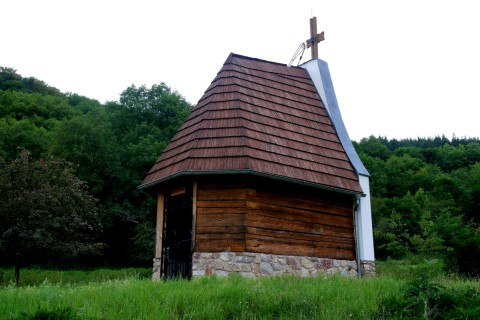Social distancing lessons from the anchoresses
It takes more than isolation to make us into contemplatives.

I once spent a night enclosed in a cell attached to a medieval church while I was researching a book on medieval holy places. The church’s newsletter enthusiastically announced, “The anchoress has returned!” Parishioners pitched in, passing meals to me through the anchorhold’s window, just as would have been done in the late Middle Ages when other women were enclosed in this place. Like me, these women entered voluntarily. Unlike me, they entered for life.
The anchoretic life may not be a sought-after vocation today, but by the end of the Middle Ages, hundreds of laypeople chose to live in permanent, solitary enclosure in the middle of England’s bustling towns. These would-be contemplatives were given the last rites by the bishop before being enclosed in tomb-like dwellings attached to parish churches.
Read our latest issue or browse back issues.
If the anchorhold’s stone walls emphasized the anchorite’s renunciation of the world, its three windows—one into the church, one facing the street, another facing a parlor—were reminders of her continued connection to and reliance on it. Anchorites were to be the living dead, inhabiting the liminal space between heaven and earth. Distanced from the world and freed from the distractions of the active life, they could devote themselves completely to contemplation and intercession.
Yet medieval guidebooks for anchoresses make clear what many of us are learning these days: enclosure alone does not a contemplative make. Self-distancing has always been difficult, even for those who choose it. It takes a step of faith to enter a space of isolation; it requires even more faith, patience, and resilience to remain there and find contentment, especially when the value of solitude is not immediately apparent. Can we learn from these contemplative forebears how to make the most of social distance and isolation?
We might first acknowledge that the transition from the active to the contemplative life comes more naturally to some than others. One young woman, Christina Carpenter, pursued life as a recluse with great enthusiasm. But the experience of the anchorhold seems not to have suited her. Or perhaps it didn’t yield the transformation she had expected. The records don’t reveal why she left, but she was soon reported by neighbors to be “gadding about” the countryside, a serious offense given that she had made a vow of stability.
While stories of runaway anchoresses like Christina are few and far between, the unique challenges of the solitary life—restlessness, distraction, impatience, purposelessness—echo throughout the medieval guidebooks for these solitaries, which offer practical strategies as well as spiritual guidance in the midst of self-isolation.
Some threats to the work of inner transformation drifted in from the outside world. Guidebooks instruct anchoresses not to be overly fond of their windows, warning that “the more a recluse looks outward the less inward light will she have.” I suspect an updated rule would advise against inordinate attention to social media or news—our current windows to the world.
The 13th-century guidebook the Ancrene Riwle also cautions the recluses against continued commerce with society. It seems some had turned their rooms into schools, post offices, or even farms. “You must not keep any animal except a cat,” the Riwle explains, for a recluse should not have “to think of the cow’s fodder and the herdsman’s ways, say nice things to the hayward, call him names when he impounds the cow.”
Then as now, idleness and boredom presented their own dangers. Writing to his sister, an anchoress, the 12th-century abbot Aelred of Rievaulx warns that idleness “breeds distaste for quiet and disgust for the cell.” Like monastic rules, anchoretic guides advised structuring the day with regular cycles of prayer, rest, reading, and light labor—such as sewing church vestments or clothes for the poor, tutoring maidservants, or offering spiritual direction to townspeople.
It was as important for an anchoress to stay healthy as it was to keep busy. To this end, some guidebooks advised against an overly ascetic life, going so far as to offer dietary advice (very little meat or fat, but as many vegetables as they like). Some anchorholds had gardens so that the recluses could get a little fresh air and exercise.
These guidebooks also attend to the chasm between what we may expect from solitude and the reality of how we experience it. The Ancrene Riwle observes that an anchoress might not feel the presence of God: “Our Lord sometimes leaves us alone for a while and withdraws his grace, his comfort, and his consolation, so that we find no pleasure in doing things well, and our heart’s savour is gone. And yet, at that very moment, our Lord is not loving us any the less.” There are no promises with enclosure, only the continued need for faith and patience.
I can think of no better example of patience than Julian of Norwich. Like us, Julian lived through pandemic. Like us, she also voluntarily “self-distanced.” For Julian, that self-distancing took the form of at least two decades in an anchorhold.
Many different versions of Julian circulate in our culture—the proto-feminist theologian, the cat-loving saint, the universalist mystic, the sage of suffering, the plague survivor, the first female writer in English, the soothing voice chanting that “all will be well.” But in this moment of unknowing, the thing I find most compelling about Julian is the 20-year period during which she chose a life of enclosure and meditation and does not seem to have been outwardly productive.
In 1373, when she was 30 years old, Julian had a series of visions on her deathbed while she was being given the last rites. She survived and wrote down the scenes of suffering and images of comfort that she saw. Some time later she took the vows of an anchoress and entered an anchorhold in Norwich. We know nothing about her life during that time, but I think we can assume that she structured her days like other anchoresses, in prayer, rest, reading, light labor, and counseling those who came to her window.
During this long silence, Julian reflected on her visions and wrote about them. In what’s referred to as her “short text,” she describes them. In her longer text, she explains that it took 15 to 20 years for her to understand their meaning. Twenty years is a long time. In our age of instant analysis, it is no small comfort to me that Julian did not rush to interpret her experience but sat with it, patiently waiting for its meaning to emerge.
Part of what emerges is a dazzling reorientation of the meaning of enclosure. While Julian writes nothing about living in an anchorhold, her theology is permeated with images and symbols of protective sheltering. She paints a picture of a world the size of a hazelnut cradled in the palm of God’s hand. She imagines climbing into the cavernous side wound of Christ and resting there. She describes herself as wrapped or clothed in God’s love.
The anchorhold is often represented as a tomb or a prison and its inhabitants as the living dead. For Julian it is more akin to a womb, its inhabitants in the process of being formed into new life. Isolation can be a place or period of darkness, discomfort, and uncertainty where nothing seems to be happening. It may not yield up ready insights or meanings. It may feel unproductive and useless.
But for Julian, the deeper truth of enclosure is that it is also a place of gestation. To believe this requires both patience and hope. It asks us to practice watching and waiting for what may be emerging, while we shelter in place like anchorites resting in their cells.
A version of this article appears in the print edition under the title “In the anchorhold.”





